Waaaaay back in the long ago (before Covid), Patrick Masson, a French sculptor, created a digital sculpt in Zbrush that won the Spectrum Fantastic Art Gold Award. He had big plans for this personal piece, as he shared on social media at the time of his nomination:
“REFLECTION” dedicated to my Popa
“I have been working on this piece in a very condensed time and with a very special mood. It is something very different as you may see. The end piece will be realized in Bronze hopefully this year.
Sculpted in Zbrush, rendered in Redshift by my brother Thierry Masson.
I am so proud and happy to be nominated for an Award in Spectrum 26 in the Dimensional Category with this piece.
I do not often find the time to do personal works and this recognition is very important to me as it encourages me to pursue more that direction.”
 As one of our “Poole Arts Intensive Sessions” (personalized one-on-one educational classes on sculpting and/or the bronze casting process), Colin and I had been working with Patrick to help him bring that dream to fruition. He first sent images of the digital sculpt, then a rough resin print for us to use in deciding how to create the parting lines for the molds.
As one of our “Poole Arts Intensive Sessions” (personalized one-on-one educational classes on sculpting and/or the bronze casting process), Colin and I had been working with Patrick to help him bring that dream to fruition. He first sent images of the digital sculpt, then a rough resin print for us to use in deciding how to create the parting lines for the molds.
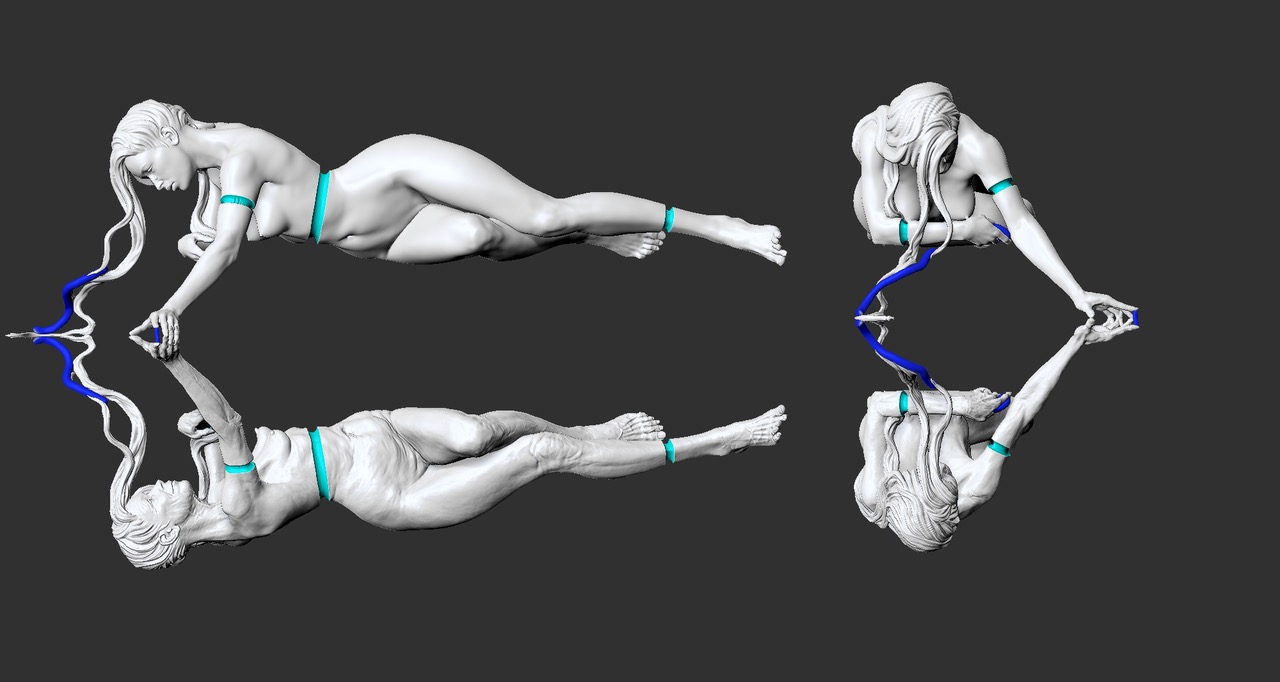 Following those guidelines, Patrick printed a high quality resin copy and shipped it out to us from France at the beginning of 2020…uh oh… you know where this story is going.
Following those guidelines, Patrick printed a high quality resin copy and shipped it out to us from France at the beginning of 2020…uh oh… you know where this story is going.
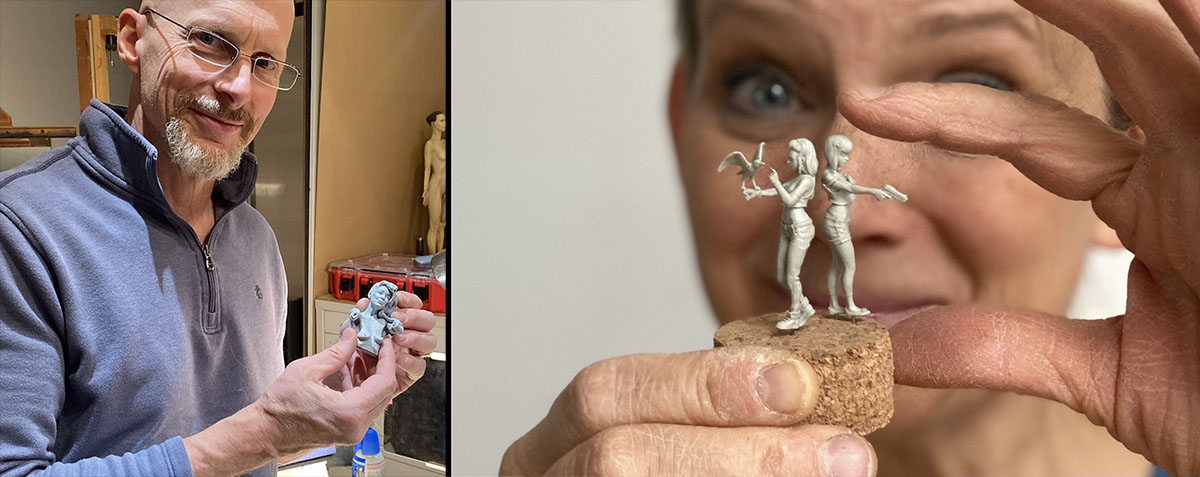
We received his sculpture and, given that our work is often life-sized, thought, it’s sooooo little and delicate! But then, looking at the usual size of Patrick’s commission miniature sculptures…
The original plan was for him to come out in Spring 2020 to learn the mold making and wax casting/dressing portions of the process. We’d send the waxes to the foundry and he’d return later in the year to weld, chase, patina and finish the bronze. Uh yeah, spring of 2020 – that didn’t happen.
Since he was unable to travel, Patrick reached out to foundries in his part of the world, only to repeatedly be told some bad news, as they saw it. French and British foundries either thought it was impossible to cast or put an exorbitant price tag on it.
Three years later and the world was opening up – it looked like “Reflection” would have a new opportunity to come into being. Patrick finally was able to fly to the states for a definitely intense few weeks at our studio.
Since the plan had changed – Patrick would only be able to come out for one longer session and we wanted him to be able to work on all the parts of the bronze process. Prior to his arrival, Colin and I made the molds, poured and dressed the first sets of waxes and sent them up to the foundry for him.

Sculpture parts being made ready for molding. Given the small scale, we chose to use a combination of traditional silicone molds for the arch and bodies and injection molds for the smaller parts – hands, feet and hair.
Patrick now had raw bronzes (and a ton of work!) waiting for him when he got here.
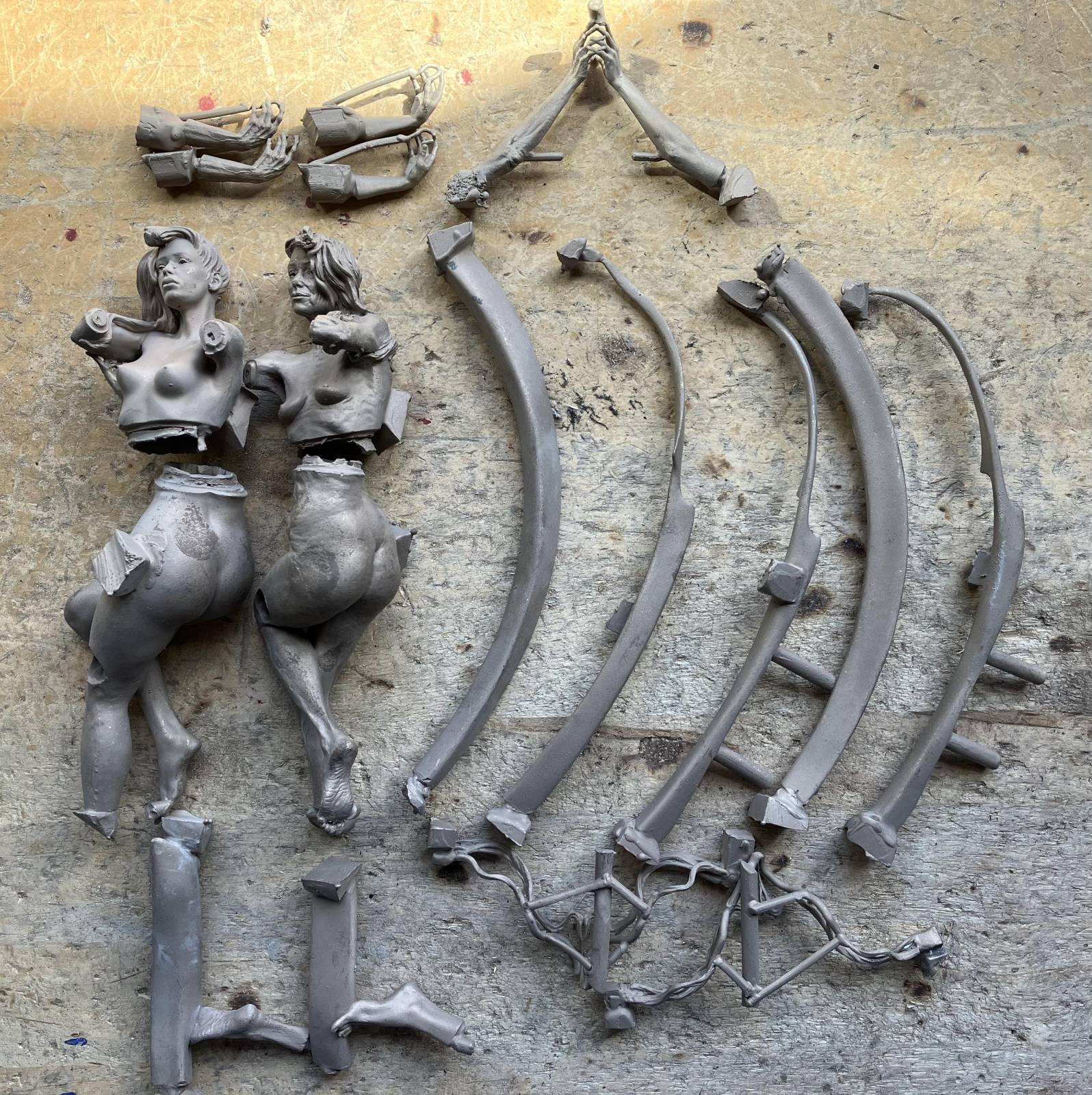 But, before we can get to that, we need to get him through the entire wax process because the foundry is coming in a week to pick up the new waxes.
But, before we can get to that, we need to get him through the entire wax process because the foundry is coming in a week to pick up the new waxes.
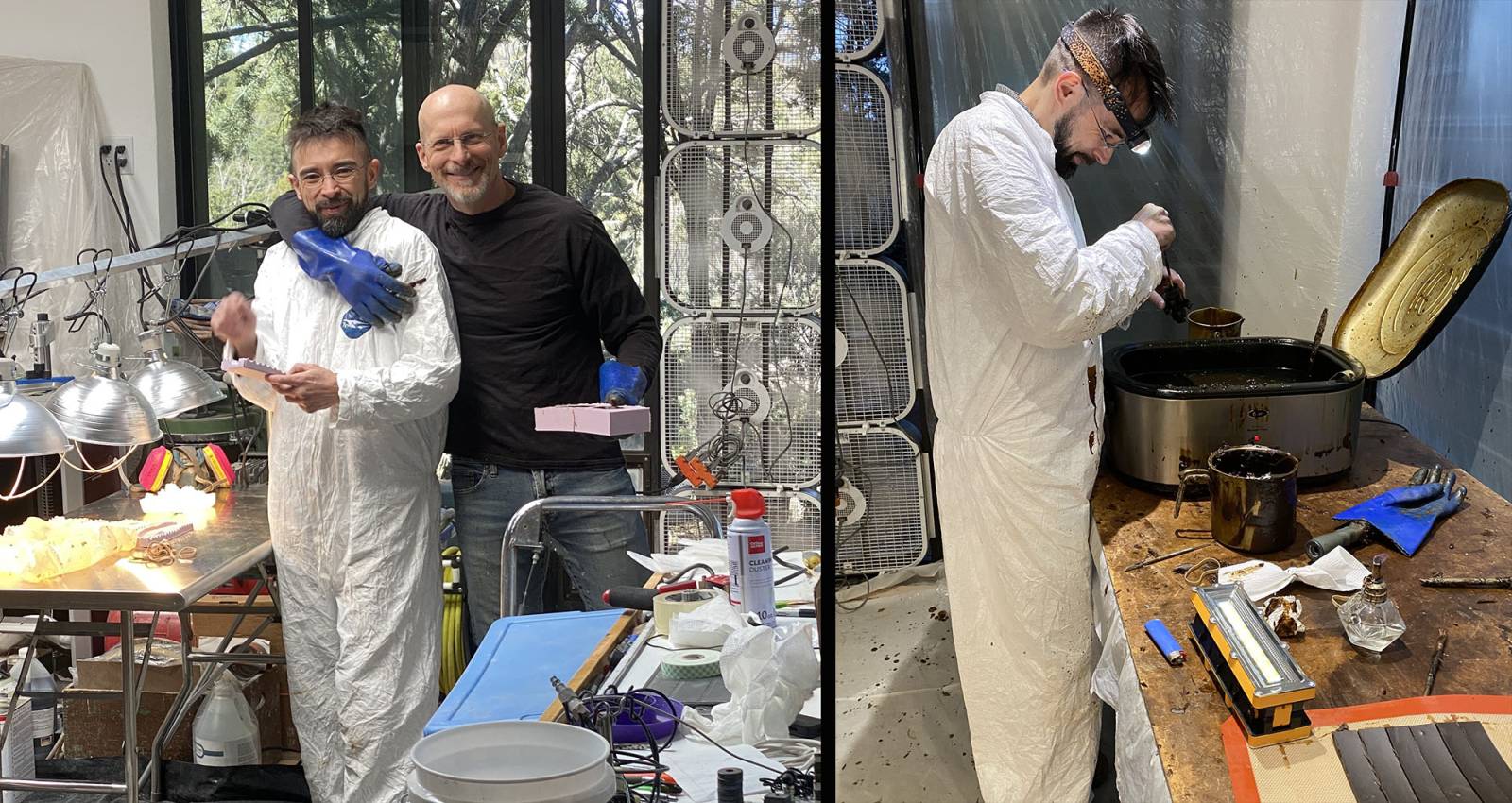 A note here: Colin and I both worked in foundries in our younger days. When you work in a foundry, unless you stay there for life, you usually only get to learn a specific part of the process. For instance, I worked in the “front end” – I did Mold, Wax, Enlargement (before digital scanning was in widespread use, mind you – we did the grid, caliper, plumb line and eyeball it method). I didn’t get to learn welding, chasing or patina. For those, I had to take classes and practice on my own. Colin was lucky enough to be the first employee at a foundry, so was able to sample most of the steps, but this is unusual.
A note here: Colin and I both worked in foundries in our younger days. When you work in a foundry, unless you stay there for life, you usually only get to learn a specific part of the process. For instance, I worked in the “front end” – I did Mold, Wax, Enlargement (before digital scanning was in widespread use, mind you – we did the grid, caliper, plumb line and eyeball it method). I didn’t get to learn welding, chasing or patina. For those, I had to take classes and practice on my own. Colin was lucky enough to be the first employee at a foundry, so was able to sample most of the steps, but this is unusual.
For an artist who comes to us to learn the bronze process, whether they’re doing it to save money on production or just want to understand the process well enough to have intelligent conversations with a foundry casting their work, we walk them through all the parts they’ll need to be familiar with.
Back to waxes: pour the stuff in the molds, let it cool, take it out and you’re good to go, right? Easy-peasy, right? Nope. Every mold has its own peculiarities that need to be worked out. Generally, the process is the similar, but each mold has its own learning curve and there’s an armload of variables and skills to develop in order to pour the perfect wax that doesn’t require days of rebuilding missing bits.
Patrick has completed four full sets of waxes to be sent to the foundry…
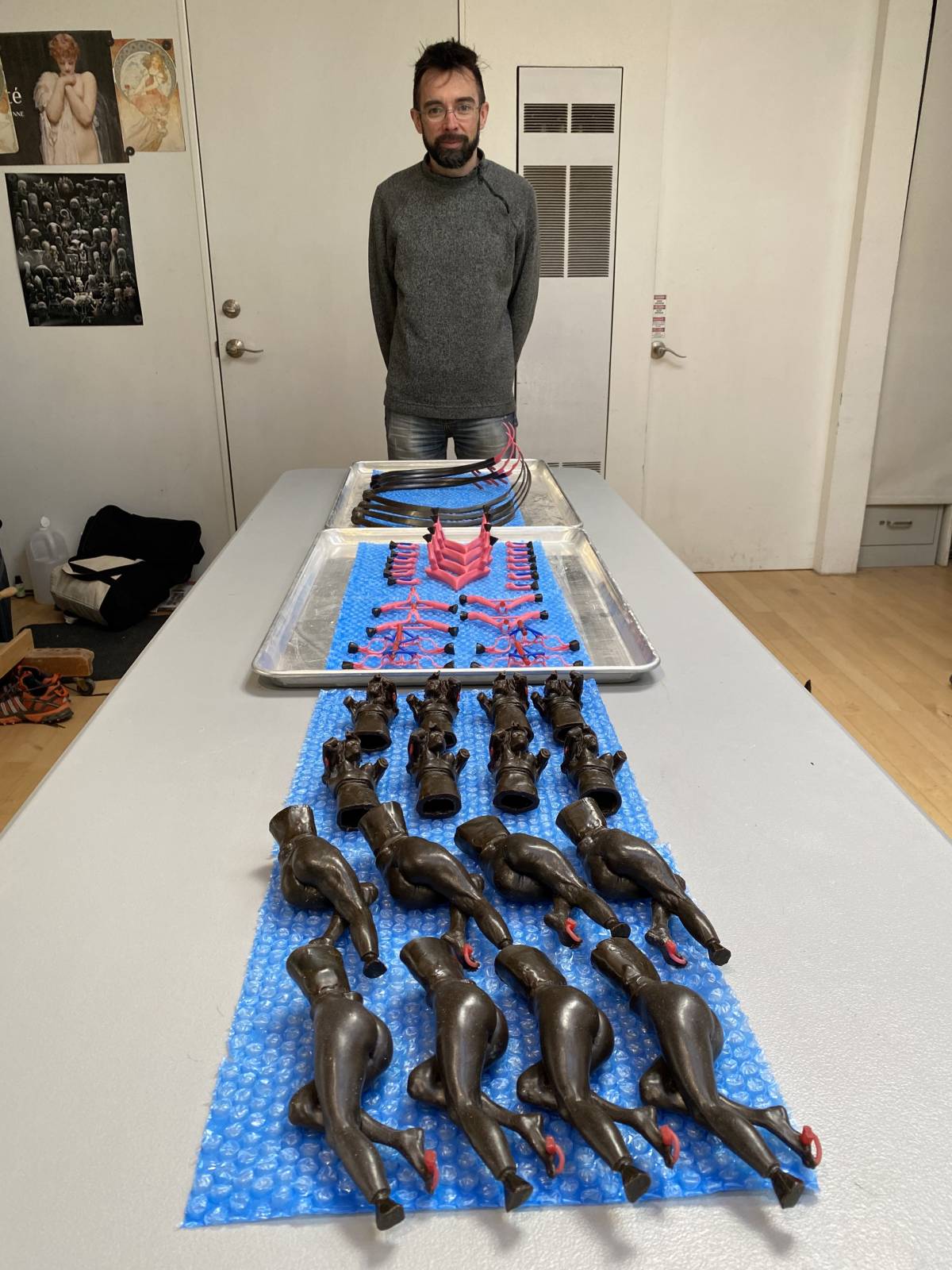 but, it took pouring all of these to get to those final four.
but, it took pouring all of these to get to those final four.
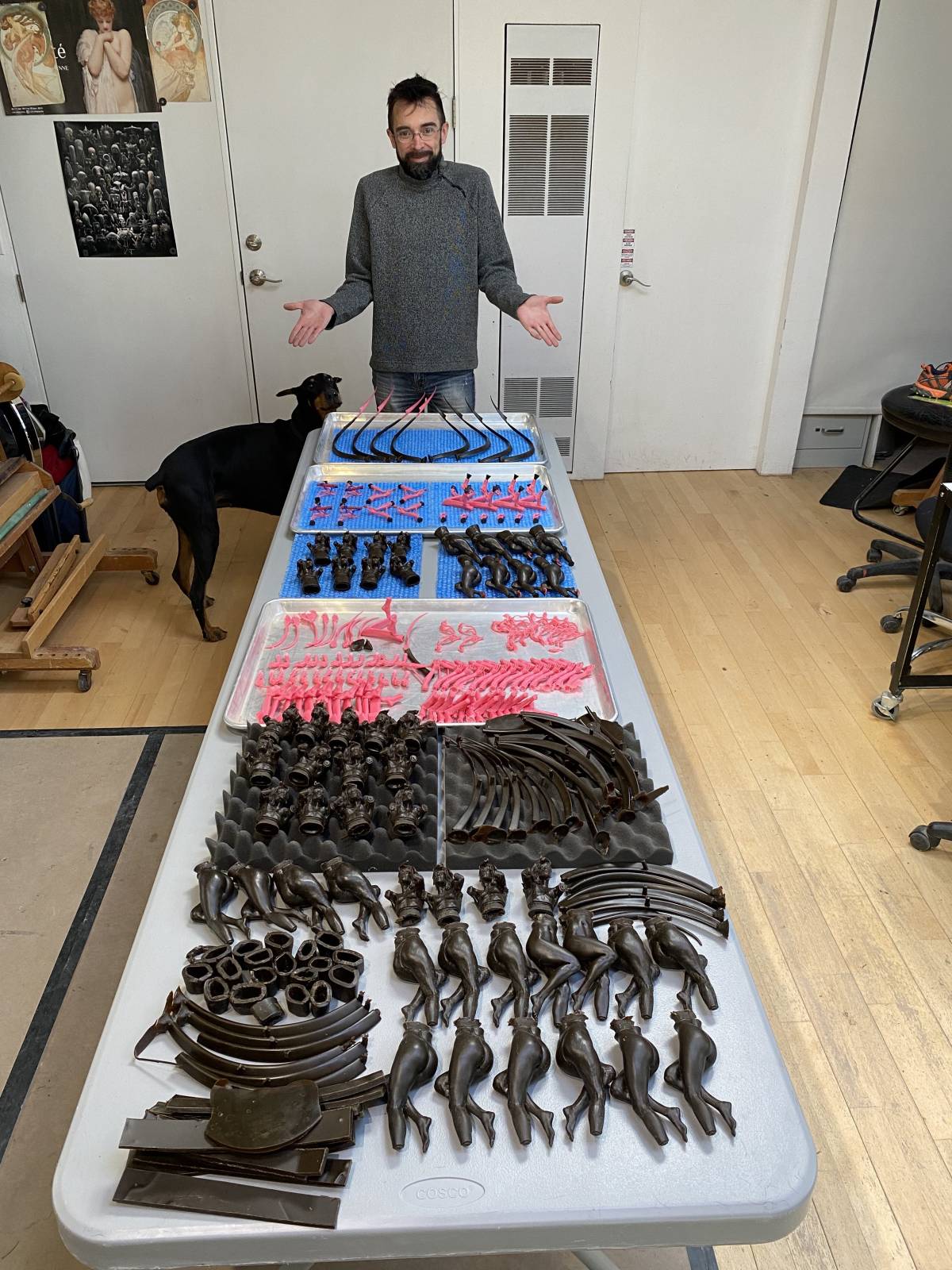 And then there’s the wax dressing/chasing – seems easy til you try it. There are many techniques and tools for dealing with seams, bubbles, de-lamination, thin spots and, you guessed it, even in the best of circumstances, there always seems to be some missing earlobes or eyelashes. But with perseverance and dedication to the task (and sometimes, a little help from our friends), it all gets done.
And then there’s the wax dressing/chasing – seems easy til you try it. There are many techniques and tools for dealing with seams, bubbles, de-lamination, thin spots and, you guessed it, even in the best of circumstances, there always seems to be some missing earlobes or eyelashes. But with perseverance and dedication to the task (and sometimes, a little help from our friends), it all gets done.
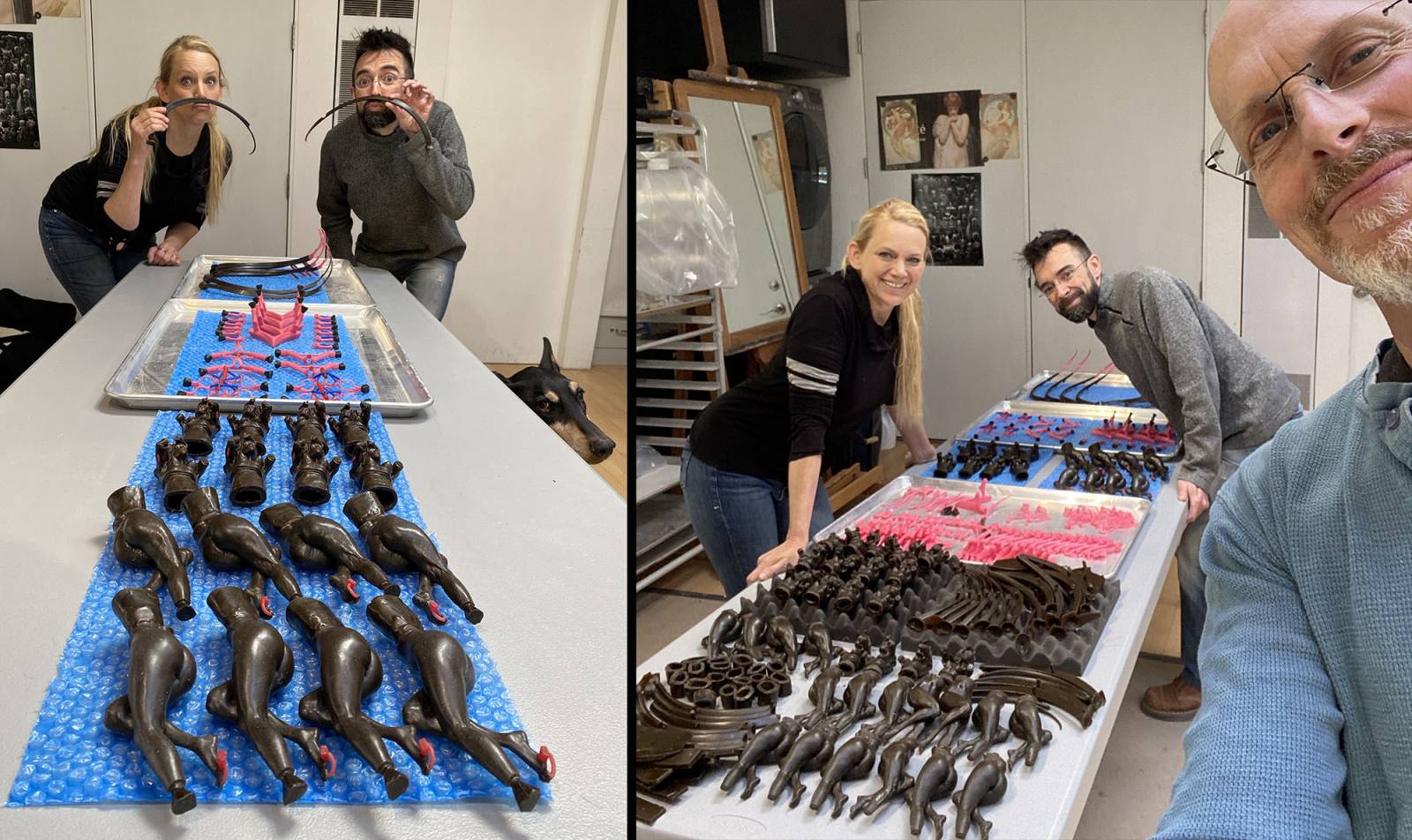 …aaaand… oh crap! We almost forgot about the sprues! When we work with our foundry, as we develop our process for each piece, we try to do the spruing (adding wax rods to facilitate the flow of air and metal in the pouring process) of toes, fingers and little bits for them as we can be tidier and that saves us both a lot of work.
…aaaand… oh crap! We almost forgot about the sprues! When we work with our foundry, as we develop our process for each piece, we try to do the spruing (adding wax rods to facilitate the flow of air and metal in the pouring process) of toes, fingers and little bits for them as we can be tidier and that saves us both a lot of work.
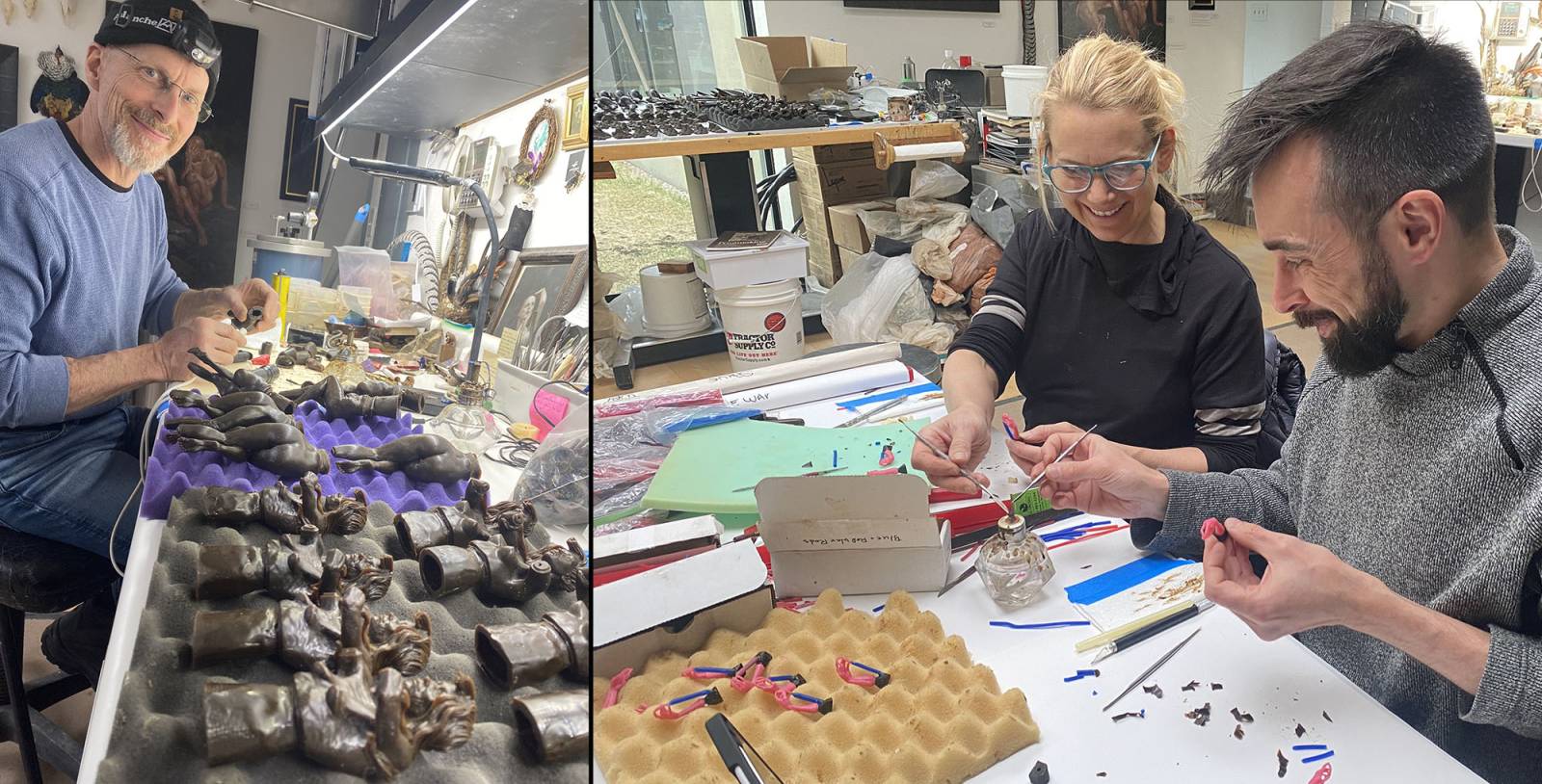 Patrick “the small” meets with Chris “the extra-large” from Madd Castings.
Patrick “the small” meets with Chris “the extra-large” from Madd Castings.
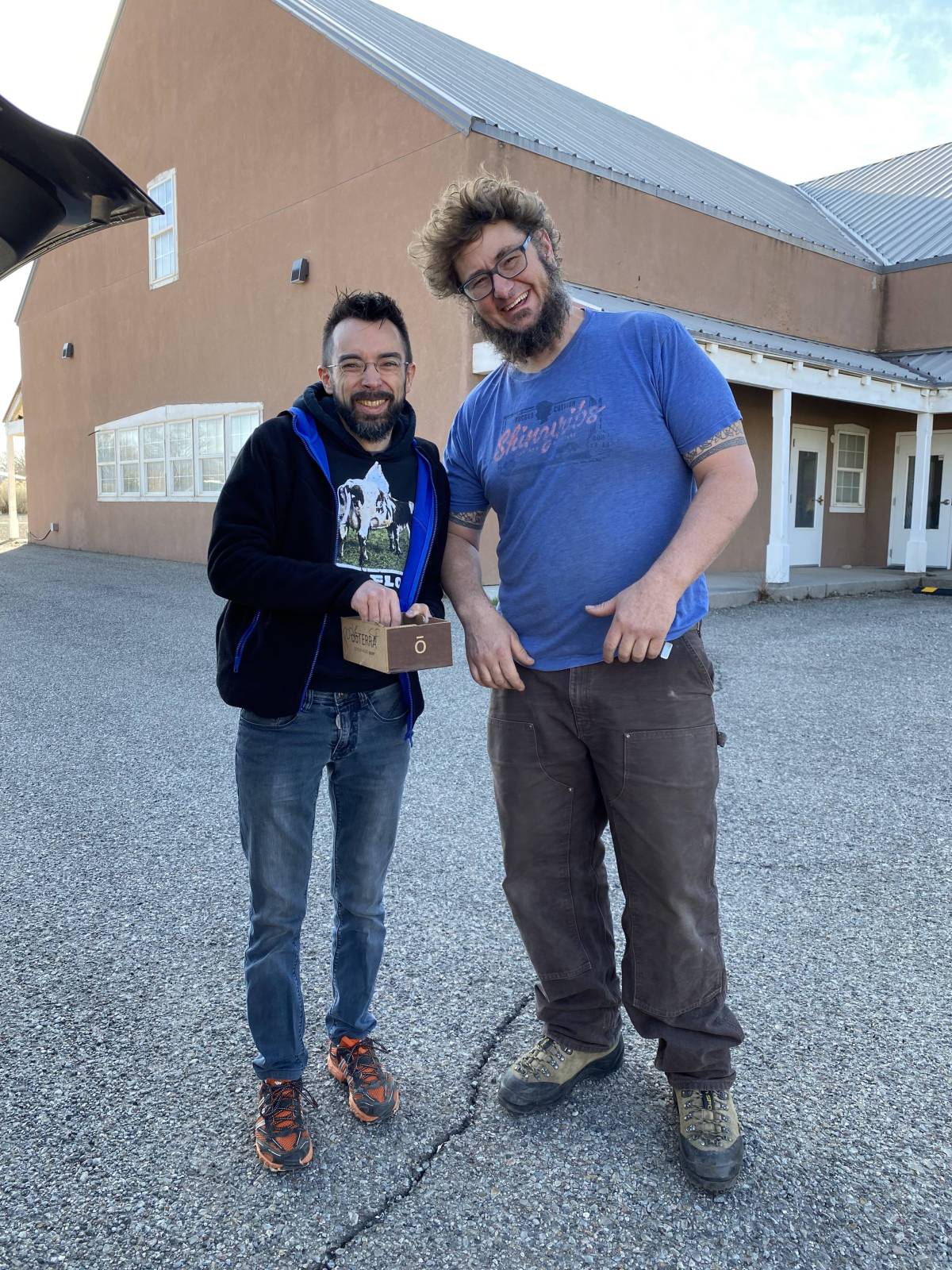 To add to the fully developed, well-rounded artist experience, what else would we do but…head to VEGAS? Yep, advanced anatomy workshop with Andrew Cawrse at Anatomy Tools! (I’ll be writing more about this experience next month)
To add to the fully developed, well-rounded artist experience, what else would we do but…head to VEGAS? Yep, advanced anatomy workshop with Andrew Cawrse at Anatomy Tools! (I’ll be writing more about this experience next month)
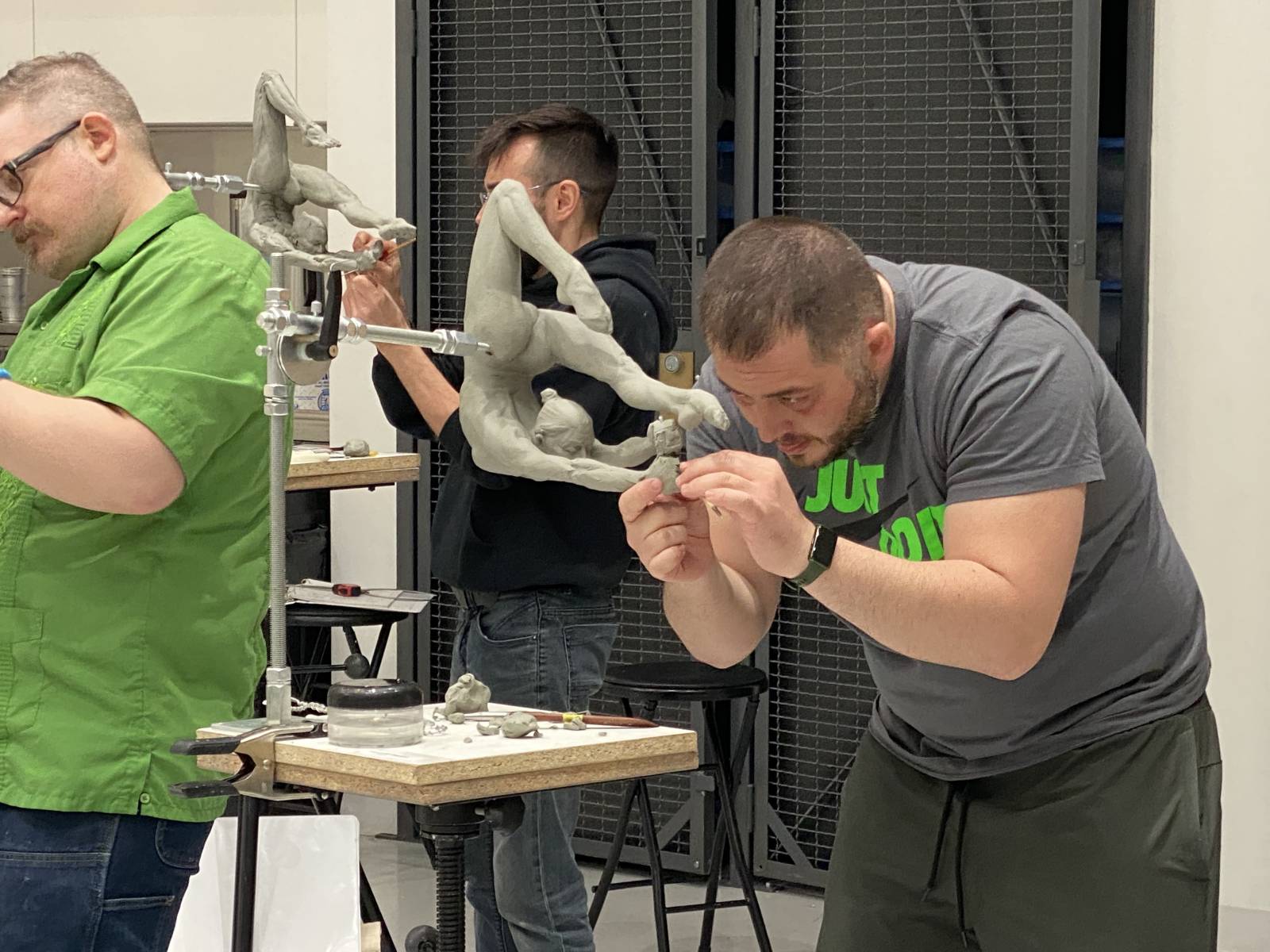 While in Vegas for the workshop, we found creative inspiration at Cirque du Soleil’s “O”, the artist collective Meow Wolf’s new installation and we even managed to find America’s version of the Eiffel Tower and the worst crepes any of us had ever had. No way we’d pass within an hour of the Grand Canyon without stopping in for a peek over the edge.
While in Vegas for the workshop, we found creative inspiration at Cirque du Soleil’s “O”, the artist collective Meow Wolf’s new installation and we even managed to find America’s version of the Eiffel Tower and the worst crepes any of us had ever had. No way we’d pass within an hour of the Grand Canyon without stopping in for a peek over the edge.
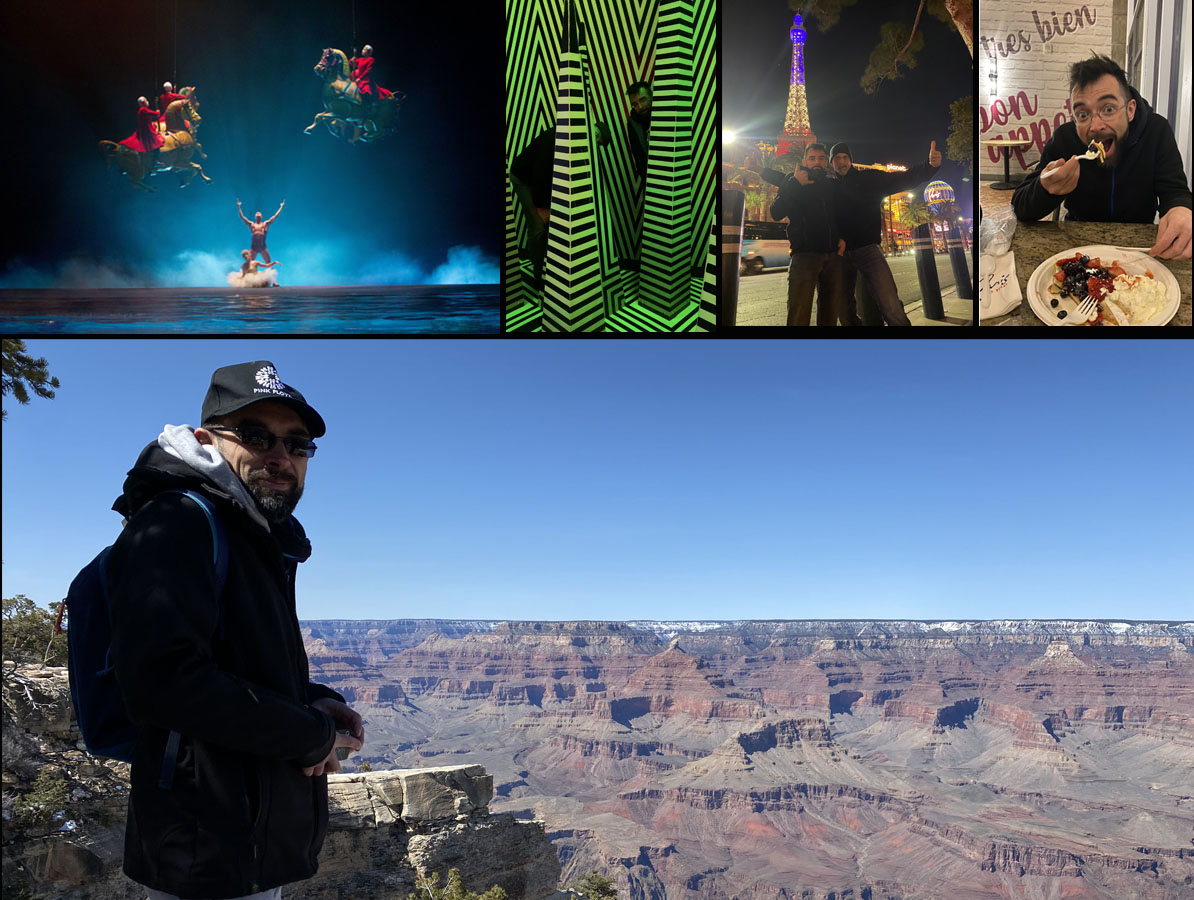 Back to the grind – literally. Next part of the process for Patrick was metal chasing – using a Foredom flexible shaft motor, carbide bits, files, sandpaper, wire wheels – whatever it takes to remove the casting sprues and re-sculpt details that miscast in the pour. This process is arduous. After the first day (and it was a very long day) Patrick came in from the shop too tired even for dinner saying, “I am destroyed. I am going to sleep.” The physicality of holding the grinder and the concentration needed in carefully removing layers of bronze to recreate forms and details can be exhausting.
Back to the grind – literally. Next part of the process for Patrick was metal chasing – using a Foredom flexible shaft motor, carbide bits, files, sandpaper, wire wheels – whatever it takes to remove the casting sprues and re-sculpt details that miscast in the pour. This process is arduous. After the first day (and it was a very long day) Patrick came in from the shop too tired even for dinner saying, “I am destroyed. I am going to sleep.” The physicality of holding the grinder and the concentration needed in carefully removing layers of bronze to recreate forms and details can be exhausting.
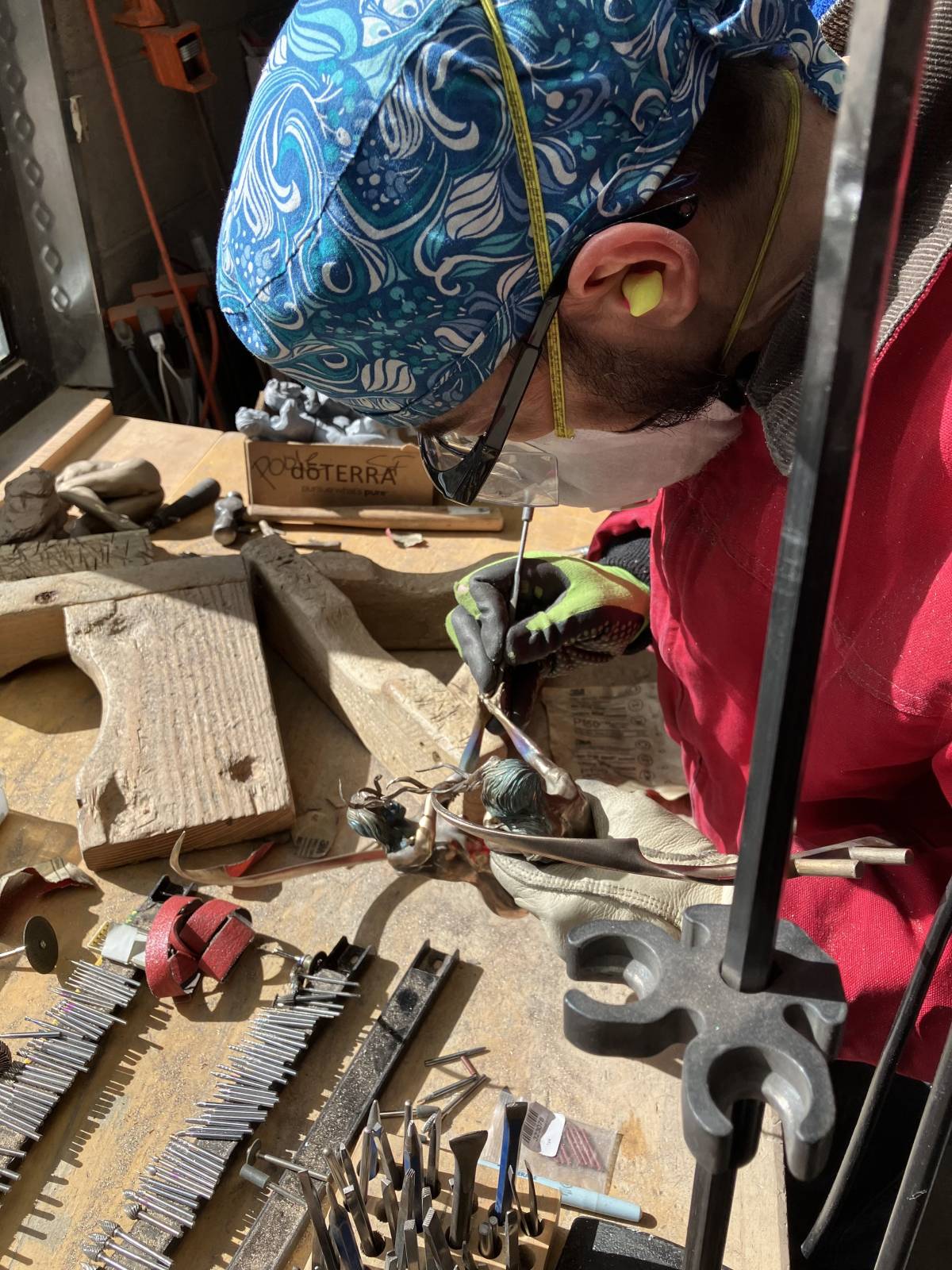 Meeting with Mike Massé, who did the welding and patina for Patrick, about how to fit the parts together. When you do the bronze process yourself rather than having a foundry do it, it is important to establish a team of professional craftspeople that understand your work and your aesthetic who can jump in on parts of the process you either don’t know how to do, don’t want to do or that they can do better than you. Mike is one of these people on our team.
Meeting with Mike Massé, who did the welding and patina for Patrick, about how to fit the parts together. When you do the bronze process yourself rather than having a foundry do it, it is important to establish a team of professional craftspeople that understand your work and your aesthetic who can jump in on parts of the process you either don’t know how to do, don’t want to do or that they can do better than you. Mike is one of these people on our team.
 Parts all together and chasing DONE! This is always a happy moment and one that never fails to make your heart race – seeing your vision in bronze is a bit of magic every single time. And the first look at the sculpture with the patina.
Parts all together and chasing DONE! This is always a happy moment and one that never fails to make your heart race – seeing your vision in bronze is a bit of magic every single time. And the first look at the sculpture with the patina.
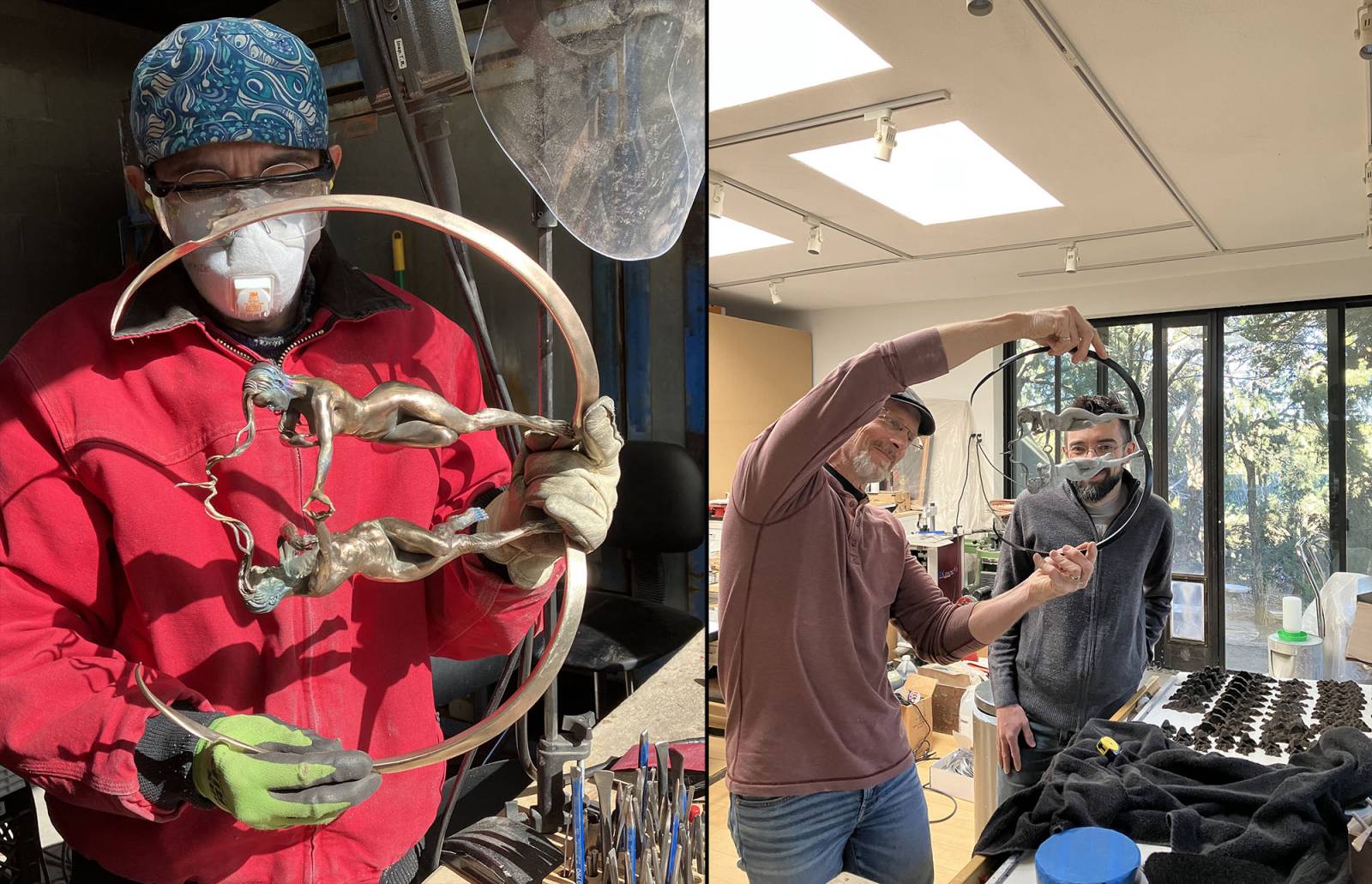 But we’re not totally done yet. Here, Patrick is applying the final wax coat to protect the patina and add a little sheen. The original design was to have a bronze base, but every time we poured the wax into the mold, it would warp, a problem that would likely have gotten worse throughout the casting process. So Patrick opted to get a granite base, which turned out to be a beautiful choice as it provided a bit of reflection. The base has to be drilled and countersunk to make space for the bolts which are welded into the bottom of the sculpture.
But we’re not totally done yet. Here, Patrick is applying the final wax coat to protect the patina and add a little sheen. The original design was to have a bronze base, but every time we poured the wax into the mold, it would warp, a problem that would likely have gotten worse throughout the casting process. So Patrick opted to get a granite base, which turned out to be a beautiful choice as it provided a bit of reflection. The base has to be drilled and countersunk to make space for the bolts which are welded into the bottom of the sculpture.
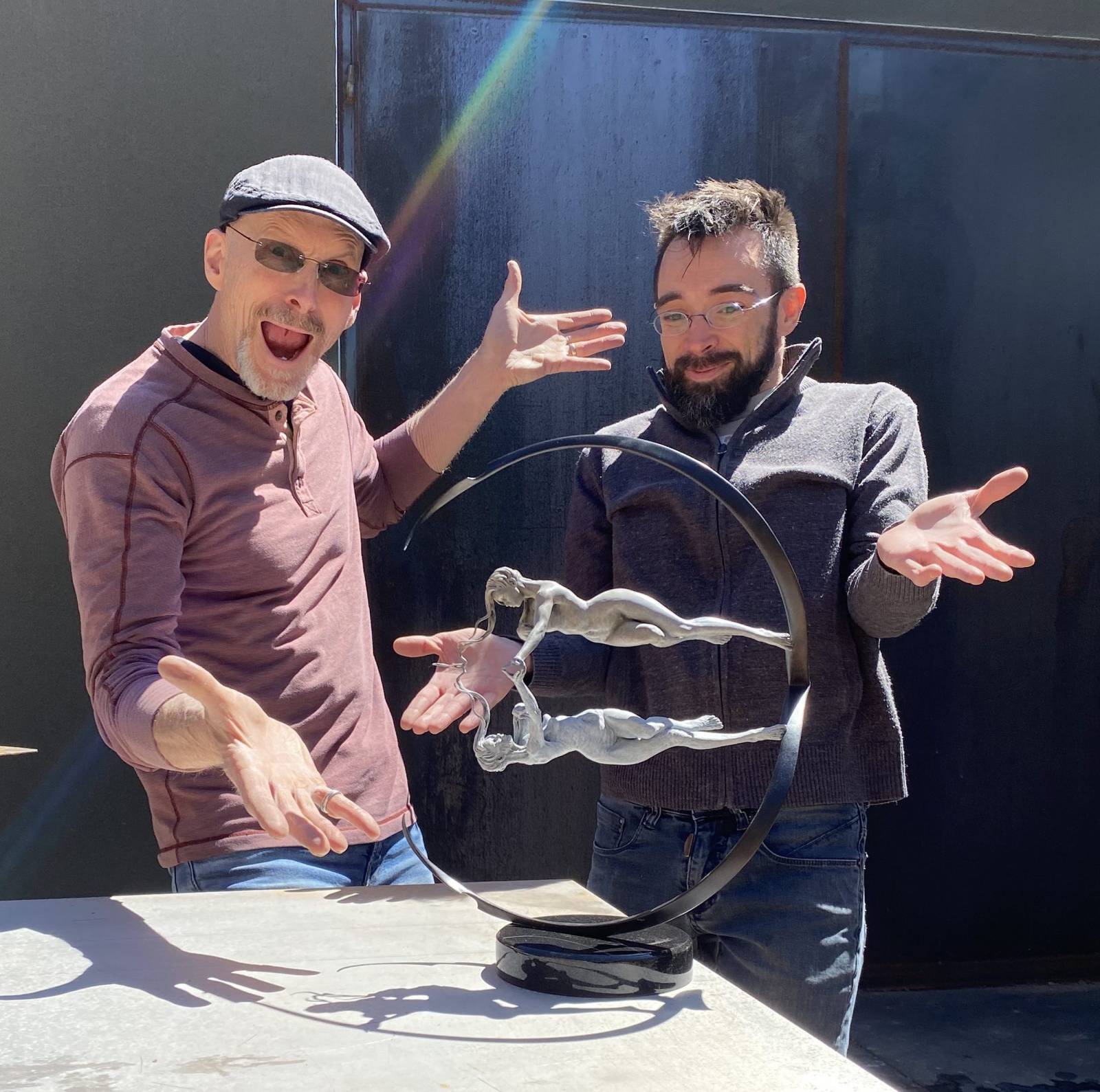 Oops – never quite done without doing the photography, but almost there…
Oops – never quite done without doing the photography, but almost there…
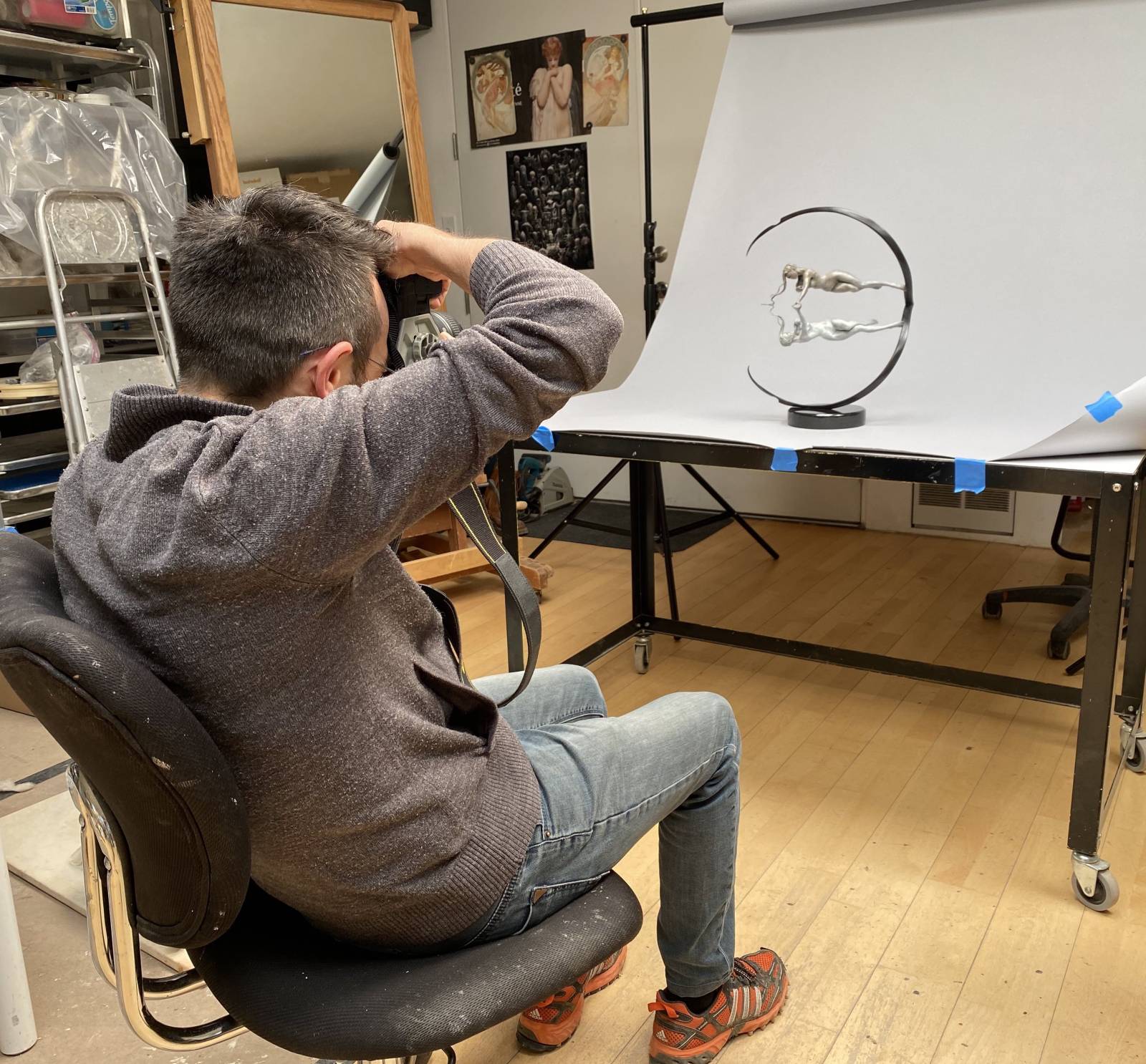 And finally, REFLECTION as the artist imagined her.
And finally, REFLECTION as the artist imagined her.
Well, we still had like two whole days before Patrick had to fly home, so we asked, why not try a little pottery, show us how to rough in a miniature, give us a Zbrush crash course, take a hike and see what doing patinas is like? Nothing like art madness, as far as we can tell!
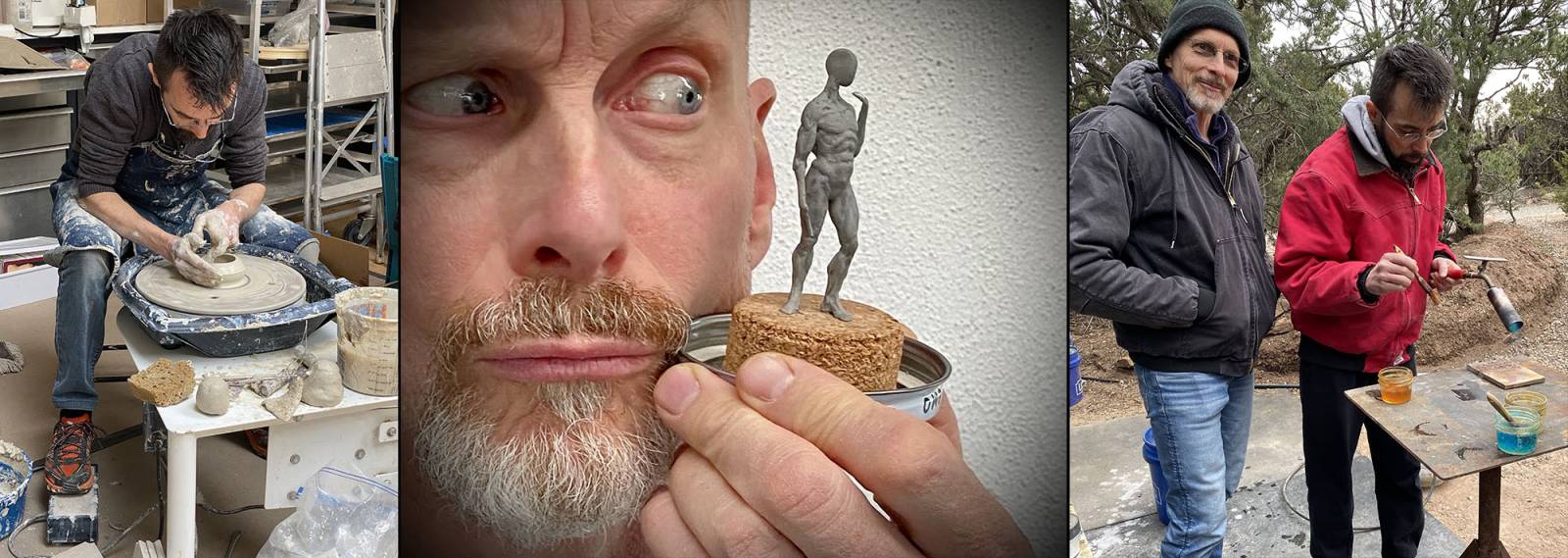 Congratulations on your first bronze, Patrick! We sure hope you loved being in the “Land of Enchantment” as much as we loved having you here.
Congratulations on your first bronze, Patrick! We sure hope you loved being in the “Land of Enchantment” as much as we loved having you here.


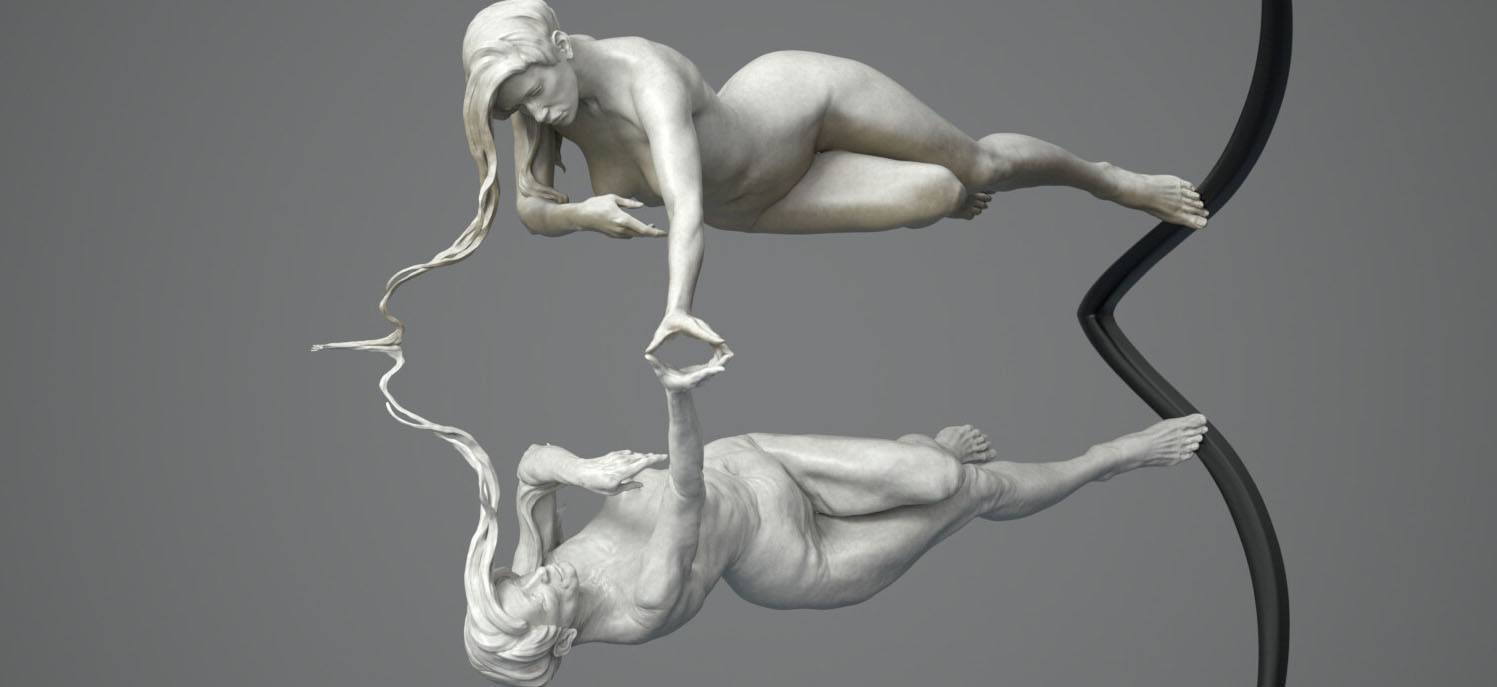
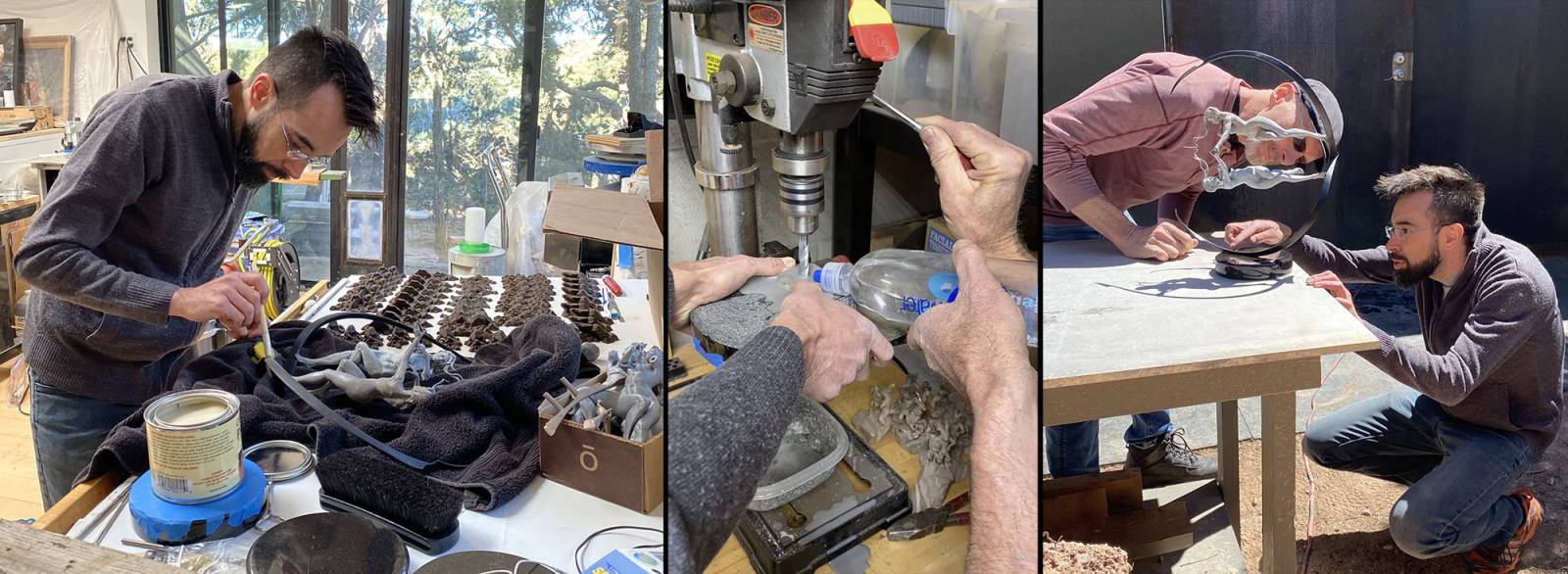
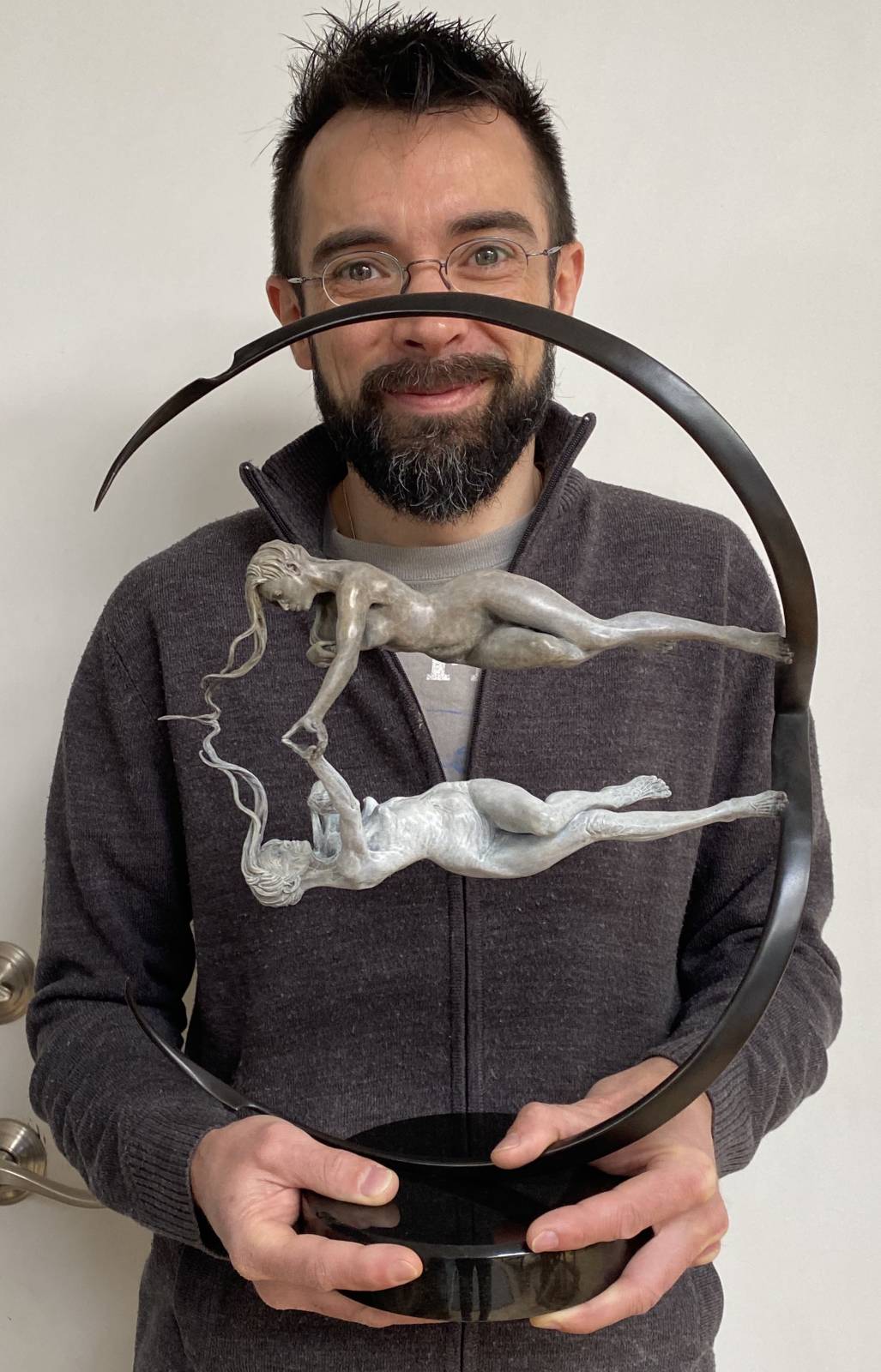
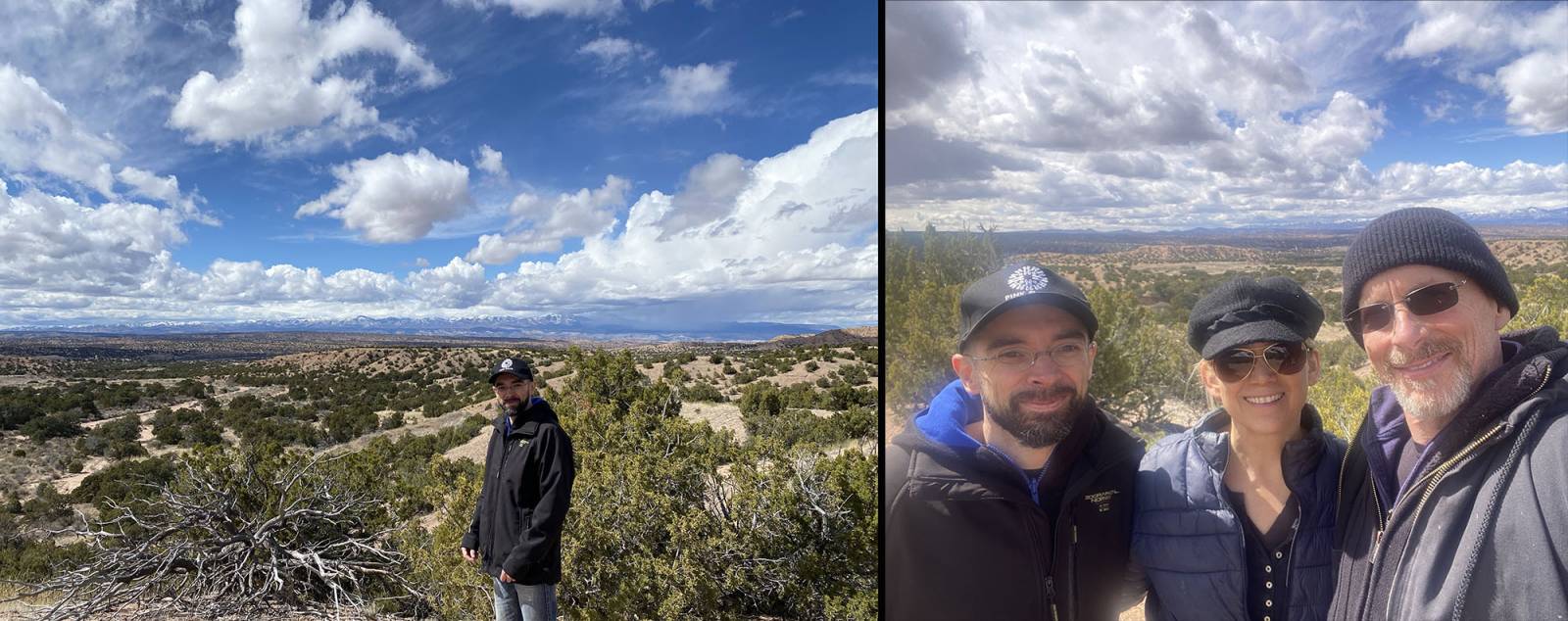
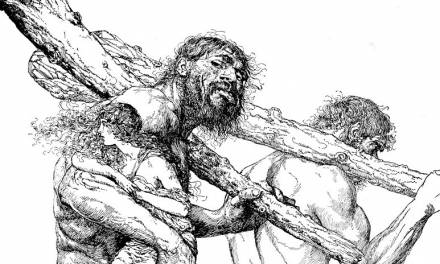
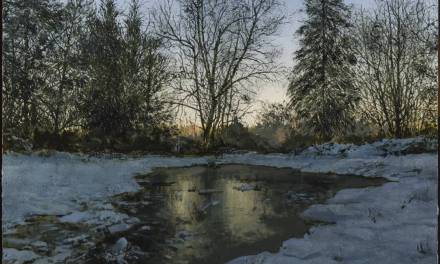
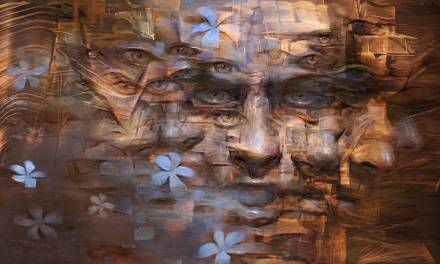
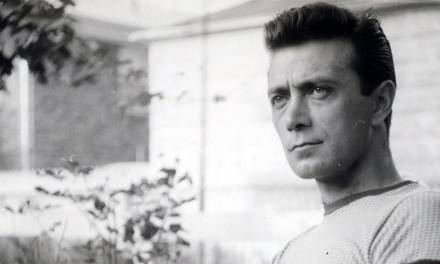

Oh wow – what an amazing journey and doubly-amazing work of art. I was blown away and then watched the video showing the piece rotating. So wonderful. And I love the young/old reflection. Bravo to everyone involved!
Hi Michael,
Yes it was quite a journey! I love knowing that the artist’s vision stays true even if there are long delays in seeing it through.
And I totally agree with you – the piece rotating is extraordinary! It would be worth figuring out how to have Reflection displayed on an auto-rotating base… maybe for his next trip out here? 😉
Thanks so much for reading and commenting! K
Thank you for this article. I see a dream that I have become achievable! Patrick is lucky to have you two as friends. Life sometimes brings together beautiful human beings and the product is pure enchantment.
Patrick, tu ne me connais pas mais tu es une de mes 9 muses. hi! hi! MERCI
Thanks for reading and commenting! Yes, we can all learn so very much from each other. The gifts of time shared are remarkable.
The ones who created this piece of art are geniuses. This piece of art will belong to eternity.
Yes, Valerii. It was an honor to get to be a small part of bringing Reflection into bronze. 🙂